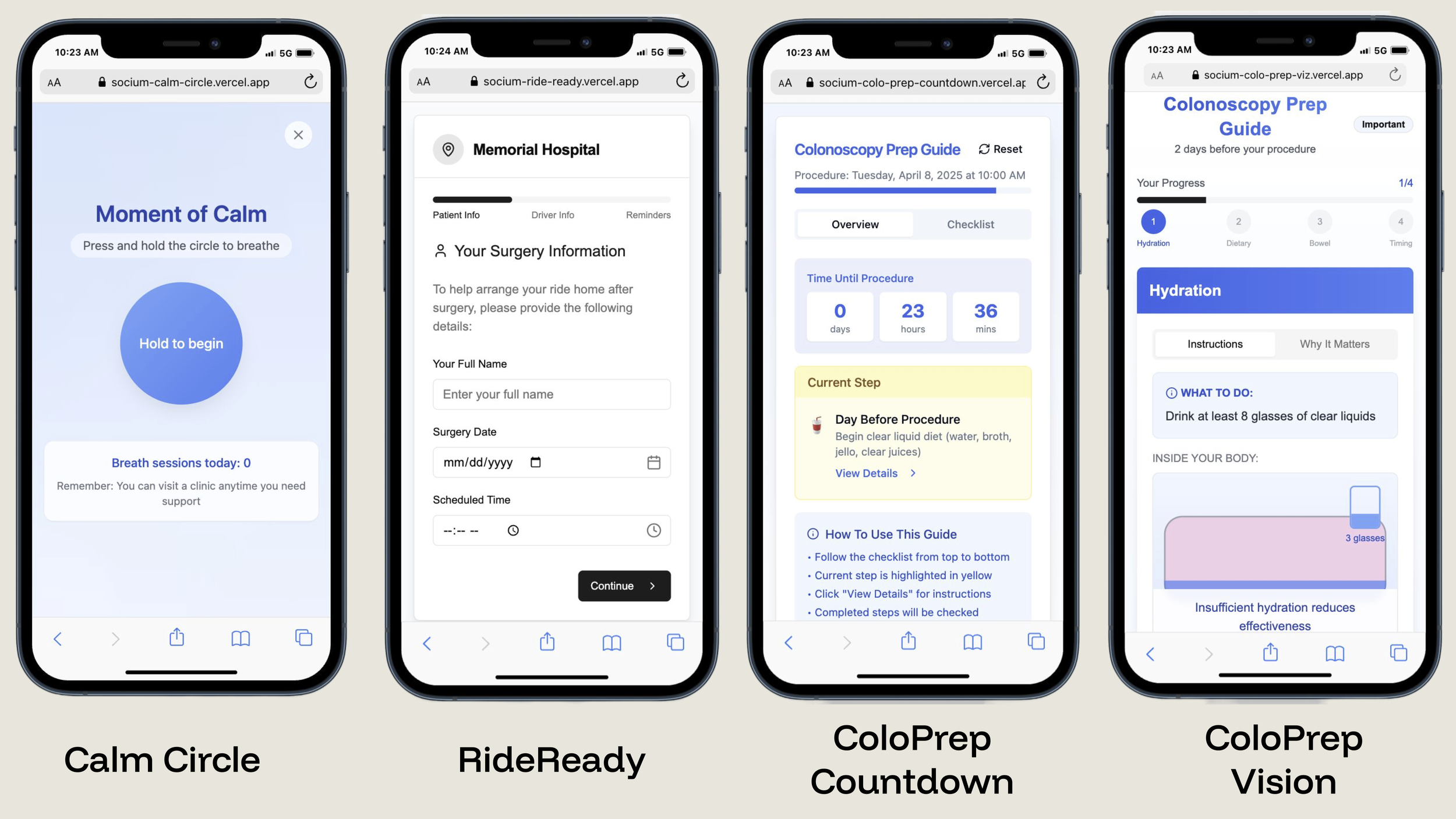AI Prototyping for Engagement in Healthcare: Accelerating the Path from Problem to Solution
The healthcare industry has long struggled with engagement challenges. Whether it's helping patients with opioid use disorder (OUD) visit clinics before crisis points, encouraging patents to sign up for nutrition services, or ensuring patients complete pre-operative requirements, behavior change remains one of healthcare's most persistent hurdles.
What if we could dramatically accelerate the process of designing solutions for these challenges?
The Power of Prototyping in Healthcare
At our recent Socium Design Lab, we tested a bold hypothesis: AI-enhanced tools could enable healthcare professionals to go from identifying a behavioral challenge to building a science-backed, functional prototype in just 90 minutes.
The results were remarkable. Four teams created sophisticated prototypes that addressed specific barriers to healthcare engagement:
Screenshots from the prototypes built at our recent Socium Design Lab
Calm Circle: A breathing exercise app for OUD patients with smart monitoring and transportation support
RideReady: A post-surgery transportation coordination system
ColoPrep Countdown: An interactive colonoscopy prep guide
ColoPrep Vision: Visualizations showing how proper prep improves outcomes
What made this possible wasn't just the technology, but a structured approach to behavior change design.
Why Prototypes Matter in Healthcare
Healthcare has always suffered from premature optimization, investing heavily in solutions before understanding if they work. Rapid prototyping flips this model, allowing for multiple iterations and feedback cycles before major investments.
The consequences of this shift are profound:
Risk Reduction: By testing multiple approaches early, organizations can identify and address potential issues before significant resources are committed
Stakeholder Alignment: Visual prototypes create shared understanding among diverse stakeholders, clinicians, administrators, patients, and technologists
Evidence-Based Design: Prototypes can be tested against actual usage patterns and engagement metrics, creating a feedback loop that strengthens the final solution
Democratized Innovation: Smaller healthcare organizations can now explore sophisticated engagement strategies previously available only to well resourced health systems
The Design Lab Framework for Engagement
To bridge concept and execution, we created a Design Lab Framework for engagement – breaking down complex challenges into interactive activities and actionable insights.
The Design Lab introduces teams to the value of AI prototyping while putting these ideas into practice. The flow guides participants to:
Identify the Target Behavior: Clearly define what specific behavioral change you're trying to achieve
Analyze Barriers: What prevents this behavior? Is it capability (knowledge, skills, memory), opportunity (access, social environment), or motivation (decision-making, habits, emotions)?
Prioritize Interventions: Which barriers have the highest impact and prevalence?
Align Tone: Match communication style to the barrier type
Select Solution Mechanics: Choose specific tactics to address each barrier
Prototype: Rapidly create a testable version using AI tools
Evaluate: Assess effectiveness and iterate
Bridging the Expertise Gap
Healthcare design has always suffered from a translation problem: clinical experts understand the medical context but may lack design skills, while designers understand user experience but may lack the clinical experience. The Design Lab enables experts without formal design training to:
Articulate ideas and see them rendered visually in real time
Explore alternative approaches without committing extensive resources
Test specific hypotheses about patient behavior with tangible prototypes
As Carly Ayres describes in her exploration of prototyping, "When something looks final, people treat it like it is. But when it looks open, they treat it like a conversation." AI generated prototypes maintain this conversational quality, allowing clinical experts to shape solutions that reflect their understanding of patient needs.
Parallel Exploration Instead of Linear Development
Parallel exploration is especially valuable in healthcare engagement, where context is crucial and no single approach works for all patients. Multiple approaches can present the core information differently while addressing varied patient barriers – something that would be resource-intensive in traditional design workflows.
As Colin Matthews notes in his blog on prototype development, "This is where AI dramatically transforms the traditional workflow. Instead of settling for a single solution due to time constraints, product managers can generate multiple AI prototypes (3-5) that explore different approaches to solving the identified problem."
For instance, in our recent Design Lab, our teams created two complementary tools for colonoscopy preparation:
ColoPrep Countdown: A step-by-step colonoscopy prep guide with interactive checklist and progress tracking that breaks complex pre-operative instructions into manageable time-based steps
ColoPrep Vision: Interactive visualizations showing how proper colonoscopy prep improves procedure outcomes
From Hours to Minutes
Overall, the Design Lab framework collapses the timeline of healthcare product and service design. Instead of consultations, wireframes, stakeholder approvals, development cycles, hours start to become minutes. Teams can:
Generate multiple visual directions simultaneously: Instead of painstakingly creating one mockup at a time, teams produce 3-5 distinct visual approaches in minutes
Convert rough ideas into clear visuals: Descriptions of features are quickly transformed into visual representations that everyone can understand and critique
Build working prototypes in real time: As stakeholders provide feedback, changes are implemented immediately, creating a truly iterative process
The Critical Role of Human Expertise
While AI powered prototyping dramatically accelerates the design process, it's crucial to emphasize that these prototypes are not perfect solutions. They're conversation starters and visual hypotheses that require human expertise to refine and validate.
The Limitations of AI Prototypes
AI generated prototypes have several inherent limitations:
Context Gaps: AI may not fully understand the nuanced clinical or cultural contexts that influence healthcare behaviors
Evidence Alignment: Generated solutions may not always align with the latest clinical evidence or behavioral science research
Implementation Realities: Prototypes may not account for real world constraints like regulatory requirements, interoperability needs, or resource limitations
Ethical Considerations: AI may not identify potential unintended consequences or ethical concerns, particularly for populations traditionally underserved in healthcare
From AI Prototype to Human Refined Solution
This is where domain expertise becomes essential. A multidisciplinary team is needed to transform prototypes into impactful engagement interventions:
Clinical Experts to identify where engagement approaches conflicted with treatment protocols or could potentially trigger adverse patient reactions
Behavioral Scientists to deign interventions and motivation strategies that align with evidence based practice
Experienced Operators to adapt prototypes to work within existing workflows and technical constraints
Looking Forward
The future of healthcare engagement lies not in perfect solutions, but in the ability to rapidly test, learn, and adapt. By combining behavioral science frameworks with AI enhanced prototyping, we can dramatically accelerate the path from problem identification to effective engagement solutions.
The New Design Mindset
As we look to the future of healthcare engagement design, several mindset shifts are emerging:
From Perfection to Iteration: The emphasis moves from getting it right the first time to learning quickly and adapting
From Expert Driven to Collaborative: Design becomes a conversation between clinical expertise, patient experience, and technological possibility
From Expensive to Accessible: Sophisticated engagement solutions become available to organizations of all sizes and resource levels
From Generic to Contextualized: Solutions can be tailored to specific patient populations, cultural contexts, and clinical settings
After years of running design, technology and behavior change workshops, we’re convinced: AI enhanced prototyping isn't just faster, it's a tool to address the complex, context dependent nature of healthcare engagement. It's not about replacing human creativity but amplifying it, freeing healthcare innovators to focus on the uniquely human elements of empathy and contextual understanding.
The result is not just better engagement tools, but a more inclusive and responsive healthcare system: a healthcare system where solutions are developed with and for the communities they serve, at a pace that matches the urgency of healthcare's most pressing challenges.


